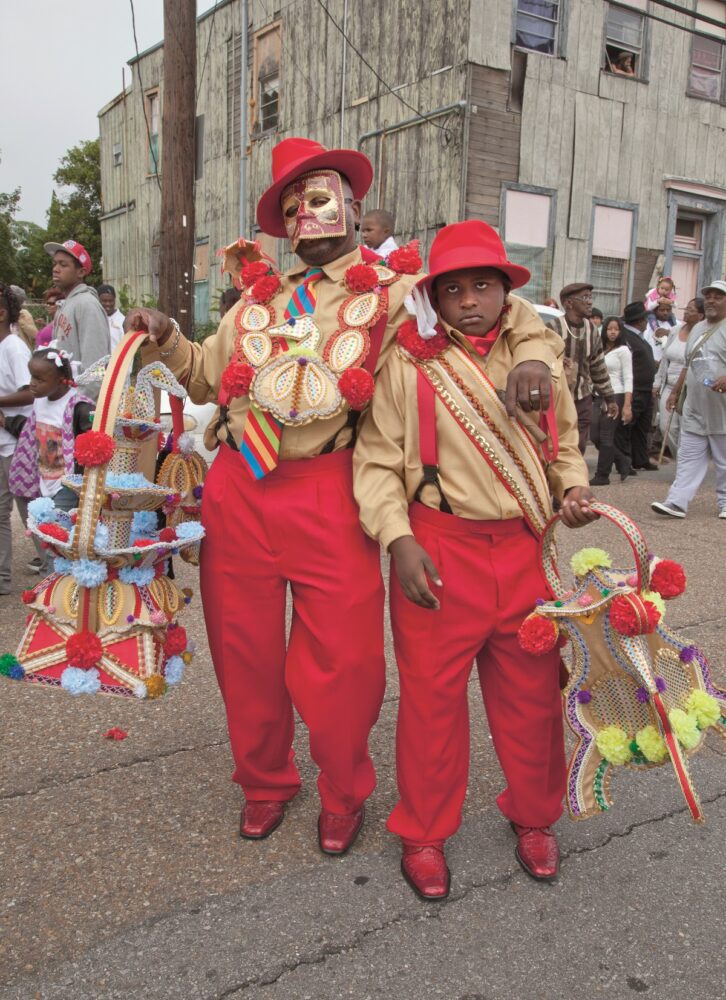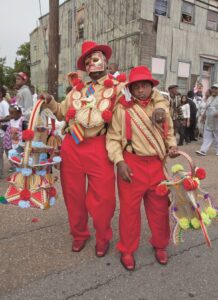Styling Out
An excerpt from the new book Dancing in the Streets explores the planning and artistry behind social aid and pleasure clubs’ finery
Published: August 31, 2021
Last Updated: December 1, 2021

Photo by Judy Cooper
Arthur Williams (left) and Dorian Jones (right) showing off baskets, yoke, and streamer made by Adrian “Coach Teedy” Gaddies, Sudan, 2010.
This beauty is the result of a year’s worth of planning, deliberation, fundraising, and coordination. It all starts with the annual choice of colors—usually two, sometimes three—which remains a closely guarded secret until the day of the parade. According to Linda Green of the Lady Rollers, “A lot of people don’t know how to coordinate colors, but when you do it right, the colors shout.” Each organization has a club color combination that they typically reserve for special anniversary years.
With some clubs, the choice of color is a democratic, sometimes difficult one made at a regular club meeting, often soon after the current season’s parade is done. “We butt heads,” said L. J. Goldstein, member of Tremé Sidewalk Steppers. With other clubs, the decision is made by one member, usually the president. For their inaugural parade in 2006, the Men of Class wore peach, cream, and lime. Anthony “Tony” Hookfin chose the combination, which, he said, some of the members didn’t like. “You can’t be scared to wear color in a second line parade,” Hookfin told them.
Almost all of the club members wear hats—men, women, and even the children. The dominant source has long been Meyer the Hatter, located just off Canal on St. Charles Avenue. Founded in 1894, it is the oldest family-owned haberdasher in the country, the largest in the South, and the first to cater to both whites and African Americans. According to Sam Meyer, grandson of the shop’s founder, the male clubs typically prefer pinch-front, snap-brim fedoras in felt or beaver. “They are not cheap hats,” he said.
But a club’s regalia is never complete without specially selected shoes. They are “the first thing [people] see when you come out the door,” said Joe Stern of Prince of Wales. Alligator shoes, or “gators,” are the gold standard. Local purveyor Rubensteins orders from shoemakers in Spain and Italy; popular brands are Mezlan and Mauri. The shoes are custom-made according to the club’s own design, sometimes featuring intricate patterns and more than one color, such as the Men Buckjumpers’ three-toned boots they sported in 2017, when they proclaimed themselves “Alligator Shoe Kings,” or the eight-toned pairs the Uptown Swingers wore in 2015. Such fancy footwear is, understandably, expensive: one pair can cost over one thousand dollars. The shoes are also time-consuming to produce—overseas orders take at least two months to arrive. More than one parade has been postponed because the shoes didn’t arrive in time.
Many of the female clubs cover the miles of their parade routes in heels. In 2010, the boots worn by the Ladies of Unity had such pointed heels that they got stuck in cracks in the street. The boots had to be abandoned before the parade had gone two blocks.
Though what clubs wear is important, what they carry as “decorations”—fans, baskets, canes, and more—sets club finery apart from any other style of dress. Today’s clubs have created many variations of the traditional basket, some so ornate and sculptural that they hardly resemble baskets at all. They’re especially important to Sudan’s decorations, even appearing as part of the club’s logo. The club incorporates several different basket designs for each parade, all made by Adrian “Coach Teedy” Gaddies, who also makes decorations for the Dumaine Street Gang and is part of the network of makers who have shared and passed on their expertise. He learned from Melvin Reed, designer for the Black Men of Labor, and Reed got his start with Jerome Smith of Tambourine and Fan and the Bucket Men. Both Smith and Reed learned from Allison “Tootie” Montana, the legendary Mardi Gras Indian Chief.
The Ole & Nu Style Fellas have made fanciful variations on canes their signature decoration. Tyrone “Trouble” Miller Jr. is responsible for the designs, but all the club members pitch in to help construct them—usually three or four different versions for each parade. “We are up all night for days before our parade,” said club cofounder Sue Press. The canes are all designed to stand alone, so that members can dance without them falling. (Press’s husband, cofounder Darryl Press, often rests his beer can in the top of his cane.) For the 2016 parade Miller took inspiration from the world of technology: on top of each cane was a life-sized replica of some kind of camera, from antique models to modern video cameras. He fashioned the replicas out of cardboard, then covered them with silks and brocades and studded them with rhinestones.
While downtown clubs tend to feature three-dimensional decorations—baskets, umbrellas, and canes—the uptown clubs favor more two-dimensional elements, such as streamers and fans. According to Kevin Dunn, one of the primary decorations craftsmen on the scene, today’s streamers evolved from a simple ribbon sash bearing the club name or logo. Most modern streamers are distinguished by large medallions featuring the club logo and/or motto for the parade. Dunn’s streamers incorporate velvet, satin, a lot of ribbon, embroidery, and sequins, sourced from Jefferson Variety Store, the family-owned business that has long serviced New Orleans’s social aid and pleasure clubs and Mardi Gras Indians.
Use of ostrich feathers for the fans is another practice borrowed from the Mardi Gras Indians. When a parader first comes out the door and pauses for effect and admiration, he holds his fans high, the giant plumes forming a majestic crown. As he dances down the street, he waves in coordination with his steps—so much so that, at a distance, a second line parade is often heralded by the flash of colorful feathers in the air.
Though clubs unofficially compete to make the biggest impression when they come out the door, each display of style and flair reinforces the cultural power of the entire social aid and pleasure club scene. With their colorful extravagance, second line parades allow each member to shine, both for him- or herself and for the tradition. “You parade up the street, and everybody’s calling your name, wanting to take a picture with you with your fancy suit,” writes the late Ronald W. Lewis in The House of Dance and Feathers. “A cigar in your mouth, hat ace deuce. Stick your feet out and show them a beautiful pair of shoes. You are signifying, “Before I go back to the normal life, I am the big shot for a day.”
Judy Cooper is a longtime New Orleanian and second line photographer. A former staff photographer for the New Orleans Museum of Art, she has spent more than twenty years documenting second line parades. More than a decade ago she made it her mission to honor the city’s social aid and pleasure clubs with a book combining history, photography, and commentary from scholars of New Orleans music, dance, and culture. Dancing in the Streets is the result.
